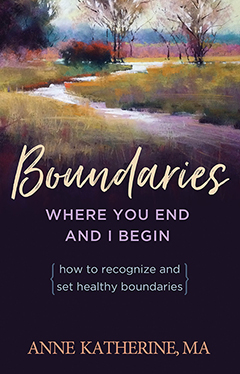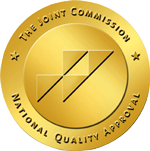
"Boundaries should be distinct enough to preserve our individuality yet open enough to admit new ideas and perspectives."

Other titles you may like.

What Went Right:
Reframe Your Thinking for a Happier Now

When Misery Is Company:
End Self-Sabotage and Become Content
Visit Recovery Road to view and
listen to all the episodes.
Episode 176 -- December 20, 2021
Build Better Boundaries: Cats, Dogs, and Healthy Relationships
No matter where we are in our recovery, boundaries affect us. We probably know we didn't have great boundaries before sobriety—they were likely too rigid or too flexible. As we move further into recovery, we're beginning to see how healthy boundaries can actually strengthen our relationships, and that they're essential to our mental and physical health.
In the following excerpt from Boundaries: Where You End and I Begin, Anne Katherine describes different types of boundaries in ways that are accessible and easy to grasp. We might smile as she explains how differently dogs and cats interact with people and with each other—and how similar those behaviors can be to the ways we relate to our partners, family members, and even strangers.
Whether we see ourselves inclined to be similar to dogs or more like cats, each of us has the power to set healthy boundaries in all our relationships. Balanced and helpful boundaries keep us connected to others while maintaining our privacy as well. No matter what, setting and caring for our boundaries always starts with us.
This excerpt has been edited for brevity.
DOGS COME WHEN THEY'RE CALLED
Boundaries come in many varieties. They can be rigid, flexible, permeable, or impermeable. They can be set at a great distance or be very close. If we agree with writer Mary Bly, dogs and cats can illustrate these differences. "Dogs," she writes, "come when they're called; cats take a message and get back to you."
My dog wants to be as close as possible to me. The great tragedy of her life is that she wants more than anything in the world to be a lap dog, but at fifty pounds she can't be. She's constantly aware of me and will even wake from a sleep to go with me. Her family is the center of her life. Her boundaries are set very close. She expects other animals to have the same close boundaries and thus gets in trouble regularly with one of our cats.
CATS TAKE A MESSAGE AND GET BACK TO YOU
My cats have very distinct boundaries. For the most part, they do only what they want. They occasionally want to be close, but they determine how close and when. After being held for a while, they've had enough. They get up and go to the other end of the couch or to some other soft place to rest. They are aware when I stand up, leave, or enter, but they do not stop what they're doing. If I walk into the room, one eye may open, but then the cat nap continues. Their boundaries are set farther out than the dog's, and their boundaries are less flexible.
One of the cats, Princess, was raised by the dog, Fluff. When Princess was a kitten, Fluff licked and nosed her all the time, sometimes licking so hard that she pushed Princess to the ground or into a wall. Now an adult cat, Princess will let Fluff do what she'd tolerate from no other creature, man nor beast. She'll strut into the room and Fluff will run up to her and lick her vigorously. Her big tongue turns Princess into a soggy mop. But the cat tolerates it, emerging like an unkempt sailor. With her surrogate mother, Princess's boundaries are flexible.
THAT'S MY BUSINESS
Boundaries can be so close that you are nose to nose with everyone you meet. If you think you have to answer any question put to you, if you think your thoughts and feelings should be revealed to anyone, your boundaries are too close.
You have a right to privacy. You choose what thoughts and feelings you want to share and with whom. No one has a right to information you want to keep to yourself. If someone asks an intrusive question, you don't have to pay the penalty for her lack of sensitivity.
Some answers to a thoughtless question are "I don't feel like talking about it." "I want to keep that to myself." "That's my business." "I'm surprised you think you have a right to that information." "Whoops! That's private."
LEAKY PARENTS
Parents with boundaries that are too close and too leaky can burden their children with inappropriate information. A child exposed to adult problems thinks she's supposed to have the maturity to handle them and worries that the parent needs more of her than she can give. Such children grow up feeling inadequate and too responsible.
ABSORBENT MATES
A person with boundaries set too close can be very vulnerable to her spouse's mood changes. Like a sponge, she absorbs every frown, every tightened jaw, and feels responsible for it. She may take on responsibility that isn't hers. She may do too much for her spouse, take over jobs that aren't her province.
In contrast, boundaries can be set too far away. A person can set fences at a great distance from her inner self. When this is the case, even an appropriate, friendly gesture can be seen as intrusive. Such a person is isolated. She'll have trouble making friends, difficulty expressing confidences even to safe people, and live in loneliness.
ESTRANGED FROM LIFE
When boundaries are very rigid, new ideas or experiences can't get in. A person who has very rigid boundaries may be difficult to bond with. Such a person has a narrow perspective on life, sees things one way, and can't discuss matters that lie outside his field of vision.
BOUNDARIES THAT ARE TOO FLEXIBLE
In contrast, one's boundaries can be so flexible that they can't hold a shape. At a neighborhood party, Eva agreed with one woman that the summer had been so hot that she'd hardly moved outside the house. Fifteen minutes later she agreed with someone else that this year the summer had been much more bearable. Eva was a chameleon. She responded to whatever was the latest demand. She'd stop to run an errand while she was driving the kids to school, and if the bank teller or cashier wanted to chat, she'd talk as long as the person wanted until the kids got too demanding to ignore.
A person whose boundaries are too flexible may feel overwhelmed with life. Each new demand distracts him. He has difficulty setting priorities and following them. He gets started on one thing only to get sidetracked by something else. He may appear disorganized.
A HEALTHY BALANCE
People from dysfunctional families can have a hodgepodge of boundaries. A husband's boundaries can be too permeable with his friends and too rigid with his family. A wife's boundaries may be too flexible when she's overeating and too rigid when she's in withdrawal from sugar. The possibilities for confusion are endless.
So what's the goal of a person who wants to be healthy? To form boundaries that have some flexibility and some definite limits, boundaries that move appropriately in response to situations—out for strangers, in for intimates. Boundaries should be distinct enough to preserve our individuality yet open enough to admit new ideas and perspectives. They should be firm enough to keep our values and priorities clear, open enough to communicate our priorities to the right people, and closed enough to withstand assault from the thoughtless and the mean.
Like any fence, wall, or curtain, each of our boundaries serves a slightly different purpose and they all need maintenance. If we notice a hole in a boundary that needs to be rigid in order to protect our emotional health, we need to fix it. If we discover that a boundary is so solid and opaque that we aren't listening to anyone with a different perspective, we need to consider allowing some permeability. Healthy boundaries protect without isolating, contain without imprisoning, and preserve identity while permitting external connections. Good boundaries make good neighbors.
About the Author:
Anne Katherine, MA, is a best-selling author and a respected therapist, now retired. She leads popular workshops and retreats, speaks at conferences, and is the author of When Misery Is Company, Where to Draw the Line, and Anatomy of a Food Addiction.
© 1991 by Hazelden Foundation
All rights reserved


